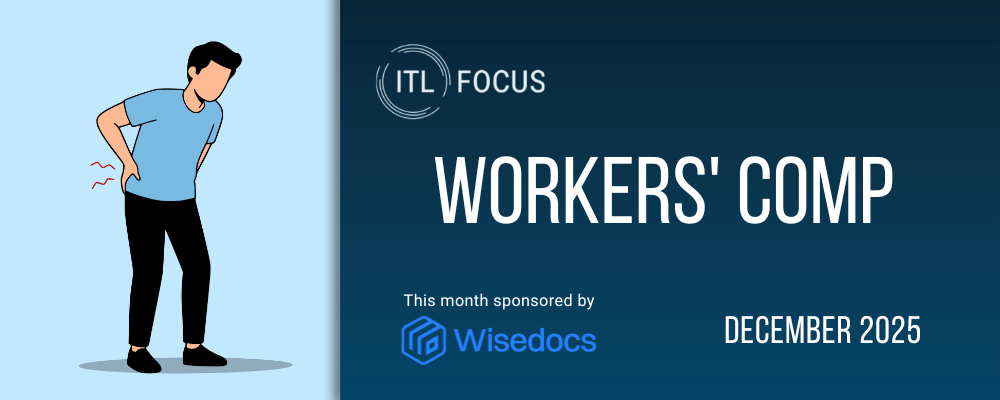 |
Mark Walls, vice president, client engagement, at Safety National and long my go-to person on workers' comp, says the industry faces a major issue with staffing -- actually, two major issues. First, clients are having trouble filling positions, so they're having to ask more of current employees and hire and onboard new employees faster, even if the pre-employment physical would ordinarily raise questions. As a result, carriers are likely to see an uptick in claims. Second, carriers and third-party administrators are having their own staffing issues. Amid the Great Resignation, it's hard for them to find enough adjusters, nurse care managers, etc. Even if the companies can find enough, they're having to pay so much more that the economics of many long-term, fixed-price contracts no longer work for TPAs. There's no simple answer, but Mark, as always, has some smart guidance. |
ITL:
What would you say the biggest issue is that people are wrestling with in the workers’ comp world these days?
Mark Walls:
The biggest issue is staffing.
So many businesses are challenged with staffing. They're trying to do more with less. So, people are working longer hours and having to do more while they're working. Employers trying to fill shifts are often compromising on the physical requirements of the job – waiving pre-employment physicals or taking candidates who are borderline on those physicals. You're rushing to get people on the job, so training isn’t always what it should be.
Add all of that together, and there's a significant concern that there's going to be an uptick in claim frequency. Some statistics are already starting to show that uptick.
Staffing is also affecting the workers’ comp industry. There's a shortage of adjusters and nurse case managers, as well as physicians, nurses and others who treat people. There's a shortage of risk-control professionals.
So you've got potentially an increase in claims and not as many people handling claims. That is a big problem.
People have positions they haven't been able to fill for months and months. That is a particular challenge for third-party administrators, which are on multi-year contracts that guarantee a certain level of staffing for a certain price. Even if they can find people to staff the work, they’re costing so much that meeting those contractual obligations is darn near impossible.
ITL:
There have been all sorts of fits and starts as businesses have brought some workers back to the office. How is that playing out in the world of workers’ comp?
Walls:
Most TPAs and carriers are not bringing people back to the office full-time. They’re finding they can't attract and keep talented people if they're not willing to allow some degree of work from home. You're even seeing that among state regulators. Ultimately, that's going to mean a lesser footprint in offices.
Work at home is also presenting some challenges. There are three or four states that have definitive cases on what constitutes a compensable claim for someone injured at home, but most don't.
Some states are positional risk: If you're at work and you get hurt, it's workers’ comp. In other states, the risk has to be inherent to the job. In a positional risk state, if I'm in the office, bend over and pick up a piece of paper and hurt my back, that's a claim. In a state that requires the risk to be inherent to the employment, I have to be lifting a box or something like that.
Throw this into a home-based environment, and you run into several issues. What constitutes being at work when you're at home? If you trip over your dog, is that a work comp injury? The answer is: It depends.
It’s important to define what the workspace is. You can't just say you can work wherever you want, because that basically opens you up to having people be considered at work when they do anything anywhere. The best practice is to have your employees have a designated workstation and send you a picture. Your risk-control people can review that workspace from an ergonomic standpoint. Having the picture also puts parameters around what is the workspace. You're not considered at work if you’re at the table in your backyard.
One of the interesting twists is that people are now working from different states than they did before. This is especially a problem for people who are self-insured, because self-insurance certificates are state-specific. If you're in California, and all your employees were in California before but now you're allowing them to work from home, some of your employees are now in Nevada or Montana or wherever. Well, your self-insurance certificate doesn't cover those people. That's something that a lot of people just didn't think about.
The one positive is that what’s being affected here are office jobs, which are lower-risk. Work in construction, restaurants, retail and so on, the higher-risk jobs, those really haven't changed.
ITL:
A point I’ve made repeatedly since getting involved with the insurance industry nine years ago is that the industry can and should move toward preventing losses, rather than just indemnifying clients after something has happened. How far along is workers’ comp in that transition?
Walls:
The workers’ comp industry has had a huge focus on loss prevention for many, many years. I mean, that's why the trend in workers’ comp has been a steady decline of frequency of claims going back 20 or 30 years. I expect that to continue in the long term.
A lot of work is being done on wearables, which can reduce workplace injury. And one of the solutions to the staffing shortage is more automation. You're starting to see that, from things as simple as ordering kiosks in restaurants to more complex work in a warehouse or manufacturing environment.
But, as I said earlier, in the short term there could be some uptick in claims.
ITL:
How about triaging, to make sure bigger problems are identified up front and to get injured workers to the right treatment right away?
Walls:
Having some type of telephonic nurse triage has already been a best practice, to evaluate whether maybe they should just go home and take some ibuprofen and rest for a day, or whether they need to get to a clinic tomorrow or whether they need to go to the emergency room tonight? Those programs have been very successful.
ITL:
How about social inflation? That’s been a huge issue in many lines of insurance; how about in workers’ comp?
Walls:
Because workers’ comp is a no-fault system, it’s somewhat insulated from social inflation. The impact is in the continued blurring of the lines between what is workers’ comp and what is not occupational.
The pandemic is the perfect example. Here is a disease that affected billions of people all over the world, yet certain states said, if you work in these occupations, it is presumed that you got this disease in the workplace. That, to me, is an example of just trying to push things into workers’ comp that weren't there before.
You see states increasing compensability around gradual onset injuries, which are part of the normal aging process. There is also the continued expansion of presumptions for first responders, especially for cancers. Again, an ordinary disease of life is being pushed into the workers’ compensation space, where the science is fuzzy on whether the workplace creates a greater risk.
ITL:
Is there anything else that's top of mind that I didn't ask about?
Walls:
Workers’ comp has been fairly stable for a number of years. But you can see that costs are ticking up. If we're not already at the end of the soft market cycle, it's right around the corner. Combined ratios had gotten down to 85%, but now they're back up around 100% and are projected to go higher. Something has to give, right?







